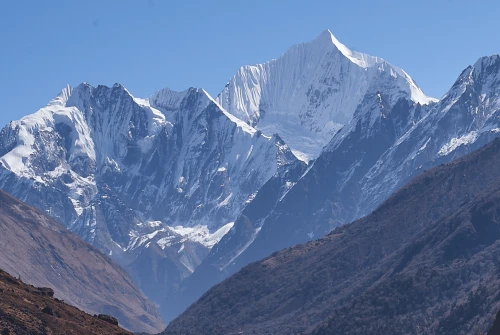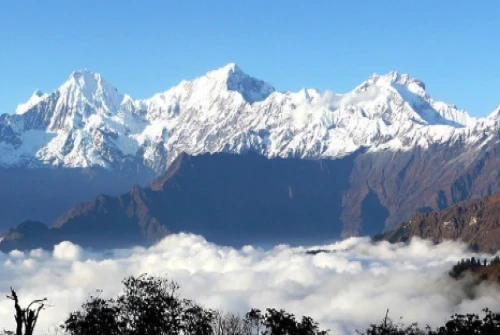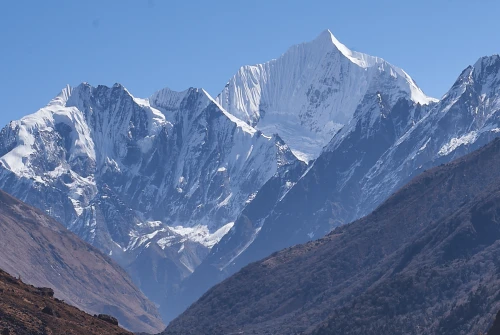Helambu Trek - 11 Days
US$565US$695Duration:8 Days Langtang Valley Trekking 8 Days
US$499US$749Duration:15 Days Ganesh Himal Trek – 15 Days
Duration:5 Days Langtang Valley Trek 5 Days
US$399US$499Duration:10 Days Langtang Valley Trek- 10 Days
US$549US$899Duration:14 Days Tamang Heritage and Langtang Trek - 14 Days
US$695US$895Langtang Helambu Trek via Ganjala Pass Trek - 14 Days
Duration:15 Days Langtang Gosaikunda Trekking - 15 Days
US$695US$850Duration:18 Days Langtang Helambu Circuit Trek- 18 Days
US$750US$899
The Langtang region is one of Nepal’s most captivating Himalayan destinations, located just north of Kathmandu in central Nepal. It lies within the boundaries of Langtang National Park, Nepal’s first Himalayan national park established in 1976, covering approximately 1,710 square kilometers. This protected area is a treasure trove of biodiversity and natural beauty, making it a must-visit destination for trekkers, nature lovers, and cultural explorers alike.
Langtang is famous for its breathtaking and diverse landscapes, ranging from dense rhododendron and oak forests to expansive alpine meadows and terraced farming fields. The region’s dramatic scenery culminates in the towering, snow-capped Himalayan peaks such as Langtang Lirung (7,234m), Ganesh Himal, and Dorje Lakpa, which dominate the skyline and offer awe-inspiring vistas for trekkers.
Langtang’s proximity to the Tibetan border means its culture is deeply influenced by Tibetan Buddhist traditions, making the area culturally unique and spiritually enriching. The local population mainly consists of Tamang and Sherpa communities, who maintain their rich cultural heritage, ancient monasteries, and warm hospitality. Trekkers can explore traditional villages such as Langtang Village, Kyanjin Gompa, and Thulo Syabru, where the lifestyle is deeply connected to Buddhist customs and Himalayan traditions.
Kyanjin Gompa, situated at about 3,870 meters, is a prominent Buddhist monastery and a key highlight of the region. It serves as both a spiritual center and base camp for trekkers aiming to explore nearby peaks, glaciers, and viewpoints. Visitors can immerse themselves in local culture while enjoying panoramic mountain views, making the Langtang region a perfect blend of nature and tradition.
The Langtang region is also known for its rich biodiversity. The Langtang National Park shelters a variety of rare and endangered species such as the red panda, Himalayan black bear, musk deer, and numerous unique bird species, offering excellent opportunities for wildlife enthusiasts and photographers.
The best time to visit Langtang for trekking is during the spring (March to May) and autumn (September to November) seasons, when the weather is clear, and the rhododendron forests are in full bloom. These seasons provide ideal trekking conditions with moderate temperatures and excellent visibility of the Himalayan peaks. However, with proper preparation, trekking is possible during winter and monsoon seasons as well, though trekkers should be cautious of snow and rainfall.
In recent years, the Langtang region has become a focus for sustainable tourism and conservation efforts aimed at preserving its fragile ecosystem while improving the livelihoods of local communities. Responsible trekking practices and eco-friendly initiatives are encouraged to protect the environment and cultural heritage.
Whether you’re looking for a moderate trek through stunning valleys, an immersive cultural experience in Tibetan Buddhist villages, or a wildlife adventure in Nepal’s pristine national park, the Langtang trekking region offers a diverse and unforgettable Himalayan experience. Its proximity to Kathmandu also makes it an accessible yet authentic trekking destination.
Features of the Langtang Region
Location & Geography
The Langtang region is situated within the expansive Langtang National Park, which covers approximately 1,710 square kilometers in central Nepal. Serving as a natural gateway to the Tibetan Plateau, Langtang encompasses spectacular valleys like the renowned Langtang Valley, often referred to as the “Valley of Glaciers” due to its stunning glacial formations and alpine environment.
Diverse Landscapes
Langtang boasts a remarkable variety of landscapes, including dense rhododendron and pine forests, terraced farmlands nurtured by local communities, wide alpine meadows, glacier-fed rivers, and rugged Himalayan peaks such as Langtang Lirung (7,234m), Ganesh Himal, and Dorje Lakpa. This diversity offers trekkers a rich sensory experience from lush greenery to snow-capped summits.
Langtang National Park
Established as Nepal’s first Himalayan national park, Langtang National Park is a crucial conservation area that protects endangered species like the elusive red panda, Himalayan black bear, musk deer, and numerous rare birds. The park is a hotspot for biodiversity and supports ongoing conservation and sustainable tourism efforts.
Cultural Heritage
The region is steeped in Tibetan Buddhist culture, which is vividly expressed through its ancient monasteries, traditional villages, and local customs. The iconic Kyanjin Gompa Monastery, perched at 3,870 meters, serves as both a spiritual center and trekking base, offering visitors breathtaking mountain views alongside an immersive cultural experience into the Buddhist way of life.
Popular Treks in Langtang
Langtang Valley Trek: This moderate trek takes hikers through scenic villages like Langtang Village and Kyanjin Gompa, surrounded by dramatic Himalayan mountain views. It’s ideal for those seeking a mix of nature, culture, and adventure.
Tamang Heritage Trail: This trek focuses on the culture of the Tamang ethnic group, guiding trekkers through traditional villages and monasteries for an authentic cultural experience.
Langtang Helambu Circuit: A longer trekking route that combines the Langtang and Helambu regions, offering rich cultural insights and panoramic Himalayan vistas.
Best Seasons to Visit
The most favorable trekking seasons in the Langtang region are spring (March to May) and autumn (September to November). During these periods, trekkers enjoy clear skies, moderate temperatures, and blooming rhododendrons. While winter and monsoon treks are possible, they require careful preparation due to snow and heavy rainfall.
Sustainable Tourism
Langtang is a model region for community-based tourism and conservation initiatives. Efforts are continuously made to protect the natural environment while enhancing the livelihoods of local residents through sustainable trekking practices, eco-friendly accommodations, and cultural preservation.
Trekking and Climbing Packages in Langtang Region
The Langtang region is a treasure trove of natural beauty, cultural heritage, and thrilling adventures. From moderate treks through lush forests and traditional villages to challenging climbs of Himalayan peaks, Langtang offers a diverse range of experiences for all levels of trekkers and climbers.
Helambu Trek – 11 Days
This scenic trek takes you through the Helambu region, known for its vibrant rhododendron forests and warm Tamang villages. It is perfect for trekkers seeking moderate altitude hiking combined with cultural immersion and serene landscapes.
Langtang Valley Trekking – 8 to 10 Days
A moderate trek showcasing the grandeur of Langtang Lirung (7,234m) and surrounding mountains. The trail includes a visit to Kyanjin Gompa monastery, offering insight into Tibetan Buddhist culture and stunning Himalayan vistas.
Tamang Heritage and Langtang Trek – 14 Days
This extended trekking experience combines cultural discovery along the Tamang Heritage Trail with the natural splendor of Langtang Valley. Trekkers will explore authentic villages, ancient monasteries, and diverse terrain on this immersive journey.
Langtang Helambu Trek via Ganjala Pass – 14 Days
Cross the scenic Ganjala Pass on this dynamic trek that blends the cultural richness of Helambu and Langtang with panoramic Himalayan views. This route offers diverse ecosystems and unforgettable nature experiences.
Langtang Gosaikunda Trekking – 15 Days
Visit the sacred alpine lakes of Gosaikunda, a spiritual and natural highlight of the region. This trek combines a pilgrimage with breathtaking mountain scenery and varied landscapes, ideal for nature lovers and cultural explorers.
Langtang Helambu Circuit Trek – 18 Days
A comprehensive circuit linking Helambu and Langtang regions, featuring lush forests, alpine zones, and rich cultural encounters. This trek is perfect for experienced hikers looking for a deep connection to Nepal’s natural and cultural diversity.
Yala Peak Climbing – 12 to 14 Days
For climbers seeking a challenging yet accessible Himalayan summit, Yala Peak (5,732m) offers an exciting adventure in the Langtang region. This climb includes trekking through beautiful villages and forests before ascending the snow-capped peak, providing stunning panoramic views of Langtang Lirung, Ganesh Himal, and other towering mountains. Suitable for trekkers with moderate mountaineering experience, Yala Peak Climbing is an excellent introduction to Himalayan peak climbing.


 based on 1 review
based on 1 review






